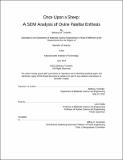| dc.contributor.advisor | Linn Hobbs. | en_US |
| dc.contributor.author | Tomerlin, Bethany M | en_US |
| dc.contributor.other | Massachusetts Institute of Technology. Dept. of Materials Science and Engineering. | en_US |
| dc.date.accessioned | 2013-01-07T19:06:24Z | |
| dc.date.available | 2013-01-07T19:06:24Z | |
| dc.date.copyright | 2012 | en_US |
| dc.date.issued | 2012 | en_US |
| dc.identifier.uri | http://hdl.handle.net/1721.1/75851 | |
| dc.description | Thesis (S.B.)--Massachusetts Institute of Technology, Dept. of Materials Science and Engineering, 2012. | en_US |
| dc.description | This electronic version was submitted by the student author. The certified thesis is available in the Institute Archives and Special Collections. | en_US |
| dc.description | Cataloged from student submitted PDF version of thesis. | en_US |
| dc.description | Includes bibliographical references (p. [55-56]). | en_US |
| dc.description.abstract | In tendon injury repair, the insertion of the tendon into the bone or enthesis often determines the quality of healing and poor enthesis often leads to treatment failure. However, natural enthesis is not very well understood and it is believed that the preparation methods of previous enthesis studies corrupted the observed mineral phases present. In order to address this controversy, this research prepared two sets of samples from where the patellar tendon joins the tibia in an ovine model. One set of samples was prepared for study via SEM using aqueous solvents whereas the other set was prepared using anhydrous solvents with the intention of comparing the mineral phases present between the two sets of samples. The fibrous material observed in the set of samples prepared using aqueous solvents was determined to be a membrane sheath and not tendon and thus the results could not be compared with the anhydrously prepared samples. The electron micrographs generated from the anhydrously prepared samples are ambiguous with some of them showing the physiologically incorrect scenario of the tendon connecting directly to the trabecular bone. Due to failure in experimental setup and ambiguous data no conclusions about the effect of sample preparation on mineralization phases could be drawn. Nevertheless, this work contributed to the field of research by producing electron micrographs of the patellar enthesis region in samples used prepared using anhydrous solvents. | en_US |
| dc.description.statementofresponsibility | by Bethany M. Tomerlin. | en_US |
| dc.format.extent | [61] p. | en_US |
| dc.language.iso | eng | en_US |
| dc.publisher | Massachusetts Institute of Technology | en_US |
| dc.rights | M.I.T. theses are protected by
copyright. They may be viewed from this source for any purpose, but
reproduction or distribution in any format is prohibited without written
permission. See provided URL for inquiries about permission. | en_US |
| dc.rights.uri | http://dspace.mit.edu/handle/1721.1/7582 | en_US |
| dc.subject | Materials Science and Engineering. | en_US |
| dc.title | Once upon a sheep : a SEM analysis of ovine patellar enthesis | en_US |
| dc.title.alternative | SEM analysis of ovine patellar enthesis | en_US |
| dc.type | Thesis | en_US |
| dc.description.degree | S.B. | en_US |
| dc.contributor.department | Massachusetts Institute of Technology. Department of Materials Science and Engineering | |
| dc.identifier.oclc | 821211961 | en_US |
